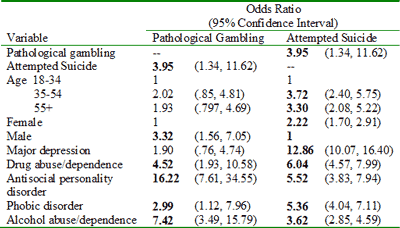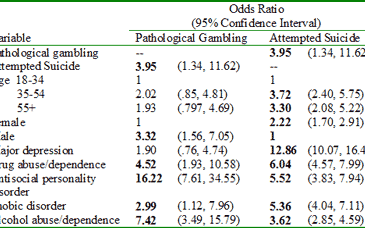Last week, The WAGER discussed research suggesting that underlying depression in pathological gamblers might contribute to the high levels of suicide ideation found in this population. This week, The WAGER continues this important discussion by reviewing a study that attempted to clarify the complex relationships among suicide, mental illness, and pathological gambling.
Newman and Thompson (2003) analyzed data from two telephone surveys of mental disorders, one conducted between 1983 and 1986 and the other between 1984 and 1989; both surveys used the same methodology. There were 7,214 participants (71.8% response rate): all were household residents at least 18 years of age. . Participants completed version III of the Diagnostic Interview Schedule (DIS). This instrument assesses lifetime psychiatric disorders and includes a question on attempted suicide. The DIS identified 30 cases of pathological gambling.
The odds ratios summarized in Table 1 identify characteristics that were significantly associated with attempted suicide. The results reveal that pathological gamblers are nearly four times as likely to have attempted suicide as non-pathological gamblers.
Subjects with major depression were almost twelve times as likely to have attempted suicide; drug abuse/dependence, antisocial personality disorder, phobic disorder, and alcohol abuse/dependence were also significant predictors of attempted suicide.
Table 1. Crude Odds Ratios for the Lifetime Prevalence of Pathological Gambling and Attempted Suicide (Newman & Thompson, 2003)

The authors also performed a multivariate logistic regression with attempted suicide as the dependent variable and all the other variables as independent variables. As Table 2 shows, the association between attempted suicide and pathological gambling is no longer significant when other mental conditions are included in the model.
Table 2. Logistic Regression Model with Lifetime Prevalence of Attempted Suicide as Dependent Variable (Newman & Thompson, 2003)

Suicide attempts are a very sensitive issue and telephone respondents might be reluctant to share this information. The reported associations might therefore be conservative. Additionally, analyses used the lifetime prevalence of suicide attempts, mental illness and pathological gambling without regard to chronological incidence. As the authors acknowledge, this limits their ability to make causal links. Temporal sequencing of symptoms and disorders would allow researchers to determine the order in which these conditions appeared and any differences in outcome related to this order.
Despite these limitations, Newman and Thompson’s results suggests that the association between problem gambling and suicide is more complex that commonly assumed. Mental illness is the dominant risk factor for suicide attempts. Exceptions to this rule are possible. Regardless of the underlying cause, pathological gamblers appear to be a high risk population and might benefit from an assessment of both comorbid mental illness and suicide ideation at entrance to treatment. A better understanding of the interactions among illnesses might lead to more effective treatment.
Comments on this article can be addressed to Rachel Kidman.
References
Newman, S., & Thompson, A. (2003). A population-based study of the association between pathological gambling and attempted suicide. Suicide and Life-Threatening Behavior, 33(1), 80-87.




